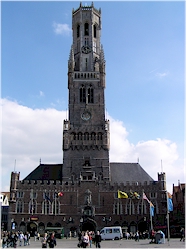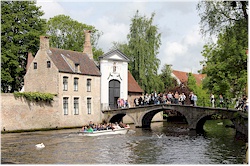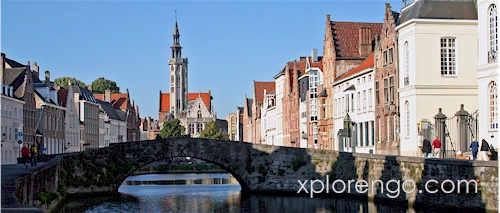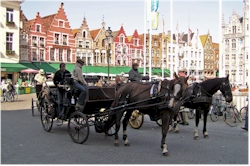|
Picture: view from Rozenhoedkaai |
|
» Eating » Sleeping facilities » Going out in Bruges » Fixed events » Beguinage » Belfry and halls » Chapel of the Holy Blood » Court of the Princes » Dunes abbey » Guild houses of Bruges » Hospices of Bruges » Jerusalem church » Nation houses » Our Ladies church » Poortersloge » St-Anna's church » St-Donatian's cathedral » St-John's hospital » St-Saviour's cathedral » Town gates » Town hall » Windmills of Bruges » Complete overview... » Archeology museum » Brangwyn museum » Brewery museum » Chocolate museum » Diamant museum » Folklore museum » Frites museum » Groeninghe museum » Guido Gezelle museum » Halve Maan » Lace museum » Lamps museum » Memling museum » Museum of Fine Arts » Salvador Dali museum » St-Janshuismill » St-John's hospital » Complete overview... » Boterhuis » Boudewijn Seapark » Burg » Canals (Reien) » Coupure » De Garre » Grote Markt » Historium » Huidevettersplein » Jan Van Eyckplein » Lake of Love (Minnewater) » Rozenhoedkaai » Simon Stevinplein » 't Zand » Complete overview...
|
Bruges (Brugge)
Brief history. It is not clear when the first settlements came to existence in the area of present-day Bruges, but traces have been found dating to the Roman period. Geographically, the location of the town is very logical: it lies on the border of the sandy area and the polders (back in the early days it was a partially flooded coastal area with navigable inlets) and the mouth of a small river called the "Reie". In the course of the 6th and 7th century, the settlement starts to develop properly. By the end of the 9th century, Bruges was already important enough for count Baldwin with the Iron Arm to build a castle in the center, making it the capital of the "pagus flandrensis" (the young Flanders which was at that time still limited to the area around Bruges). In that period, the first walls were erected to protect the town.
1568 is a year of disaster because it is the start of the 80-years war between Spain and the Northern Netherlands. When Sluis was captured by the Northern armies, Bruges was disconnected from the sea and from its most important source of income. This was the end of prosperity and one of Europe's biggest tradecenters turned into a sleeping provincial town. Lateron, the industrial revolution had only a minimal impact on the region. Due to the economic standstill, Bruges was in the 19th century even one of the poorest regions of Flanders. Bruges' mishap in that period is now it's fortune: it's historic center survived the effects of time and progress which fueled the emerge of a new industry: tourism.
Bruges, center of international trade and finance. During several centuries, Bruges was the most important town in Flanders and one of the most important ones in western Europe. Its success was the result of different factors. The base for Flanders' richess was the textile industry and related products. Textile and domestic produce were exported and goods from all over the then known world were imported via the port of Bruges for distribution to the wide hinterland. All this international commercial activity in turn attracted financers and bankers, mainly from Italy (Florence, Siena, Lombards,...). Names such as de Medici and Portinari were well known in Bruges. Bruges and art. A rich place such as Bruges obviously attracted all types of artists but it was also the birthplace of well known local artists. Just think about the priceless Flemish Primitives that can be admired in the museums of Bruges. A few names are inseparably linked to the town: Jan Van Ecyk, Pieter Pourbus, Marcus Gerards, Lanceloot Blondeel,...
Filmset Bruges. Bruges has been the setting for several local productions (series mainly) but recently also for a few bigger international movies. The most well-known probably is the crime comedy "In Bruges" by Martin McDonagh (2008) with Colin Farrell, Brendan Gleeson and Ralph Fiennes in the main roles. The town has also been discovered by Bollywood. The Indian production "Peekay (PK)" with actors Anushka Sharma and Sushant Singh Rajput has been partially shot in Bruges (2014).
|
» getting to Bruges » transport, tours, links,... » Assebroek » Bruges » Dudzele » Koolkerke » Kristus Koning » Lissewege » Male » Sint-Andries » Sint-Jozef » Sint-Kruis » Sint-Michiels » Sint-Pieters » Zeebruges » Zwankendamme
|
|
©
xplorengo.com. No information or pictures can be copied or distributed in any way
without written permission of xplorengo.com.
|



